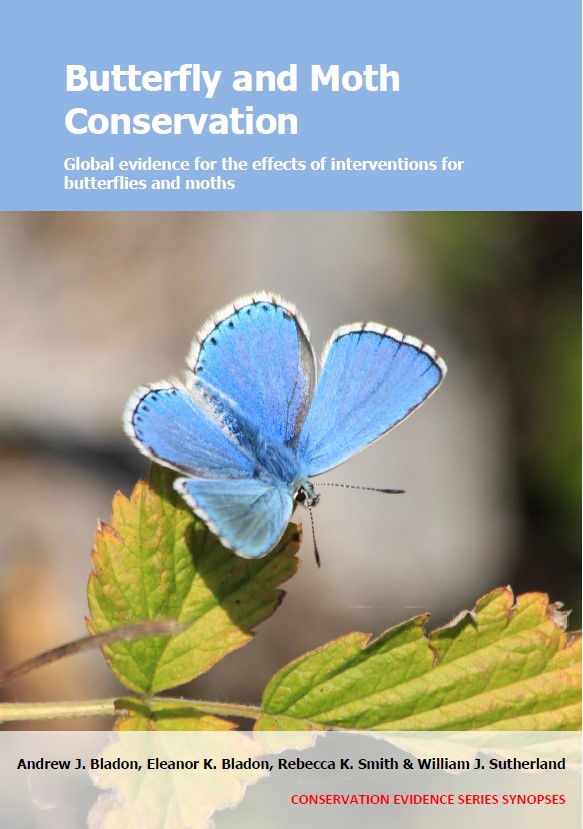Actions to conserve biodiversity
We have summarised evidence from the scientific literature about the effects of actions to conserve wildlife and ecosystems.
Review the evidence from the studies
Not sure what Actions are? Read a brief description.
Search for evidence
e.g. "frogs chytrid"
152 Actions found
Refine
Hide
152 Actions found
Download Actions
| 0 selected |
|
Order results by:
| Action | Effectiveness | Studies | Category | |
|---|---|---|---|---|
|
Use ‘warmer’ (red/yellow) lighting rather than other lighting colours Action Link |
Evidence not assessed | 5 |
|
|
|
Convert to organic farming Action Link |
Evidence not assessed | 13 |
|
|
|
Maintain species-rich, semi-natural grassland Action Link |
Awaiting assessment | 19 |
|
|
|
Translocate to re-establish populations in known or believed former range Action Link |
Evidence not assessed | 16 |
|
|
|
Increase or maintain the proportion of natural or semi‐natural habitat in the farmed landscape Action Link |
Evidence not assessed | 12 |
|
|
|
Translocate to establish populations outside of known range Action Link |
Evidence not assessed | 4 |
|
|
|
Introduce mated females to increase genetic diversity Action Link |
No evidence found (no assessment) | 0 |
|
|
|
Manage host species’ populations for the benefit of dependent parasite/mutualist species Action Link |
No evidence found (no assessment) | 0 |
|
|
|
Release captive-bred individuals to the wild Action Link |
Evidence not assessed | 13 |
|
|
|
Pay farmers to cover the costs of conservation measures (as in agri-environment schemes or conservation incentives) Action Link |
Evidence not assessed | 32 |
|
|
|
Rear declining species in captivity Action Link |
Evidence not assessed | 22 |
|
|
|
Maintain traditional orchards to benefit butterflies and moths Action Link |
Awaiting assessment | 2 |
|
|
|
Manage perennial bioenergy crops to benefit butterflies and moths Action Link |
Awaiting assessment | 1 |
|
|
|
Manage vineyards to benefit butterflies and moths Action Link |
Awaiting assessment | 2 |
|
|
|
Grow native trees within perennial crop plantations Action Link |
Awaiting assessment | 1 |
|
|
|
Increase crop diversity across a farm or farmed landscape Action Link |
Awaiting assessment | 2 |
|
|
|
Leave uncropped, cultivated margins or plots Action Link |
Evidence not assessed | 4 |
|
|
|
Leave unharvested crop headlands within arable fields Action Link |
Awaiting assessment | 1 |
|
|
|
Plant crops in spring rather than autumn Action Link |
No evidence found (no assessment) | 0 |
|
|
|
Undersow spring cereals, with clover for example Action Link |
Awaiting assessment | 2 |
|
|
|
Create beetle banks Action Link |
Awaiting assessment | 4 |
|
|
|
Manage rice field banks to benefit butterflies and moths Action Link |
Awaiting assessment | 1 |
|
|
|
Restore arable land to permanent grassland Action Link |
Awaiting assessment | 10 |
|
|
|
Plant wild bird seed or cover mixture Action Link |
Awaiting assessment | 7 |
|
|
|
Produce coffee in shaded plantations Action Link |
Evidence not assessed | 3 |
|
Download Actions
| 0 selected |
|

Butterfly and Moth Conservation - Published 2023
Butterfly and Moth Synopsis
Watch this search
If you are familiar with RSS feeds, please click the button below to retrieve the feed URL:
RSS feed for this searchIf you are unfamiliar with RSS feeds, we would suggest reading this BBC article.
Unfortunately, due to the number of feeds we have available, we cannot provide e-mail updates. However, you could use tools such as Feed My Inbox to do this for you.
What are 'Individual studies' and 'Actions'?
Individual studies
An individual study is a summary of a specific scientific study, usually taken from a scientific journal, but also from other resources such as reports. It tells you the background context, the action(s) taken and their consequences.
If you want more detail please look at the original reference.
Actions
Each action page focuses on a particular action you could take to benefit wildlife or ecosystems.
It contains brief (150-200 word) descriptions of relevant studies (context, action(s) taken and their consequences) and one or more key messages.
Key messages show the extent and main conclusions of the available evidence. Using links within key messages, you can look at the paragraphs describing each study to get more detail. Each paragraph allows you to assess the quality of the evidence and how relevant it is to your situation.
Where we found no evidence, we have been unable to assess whether or not an intervention is effective or has any harmful impacts.





)_2023.JPG)














